
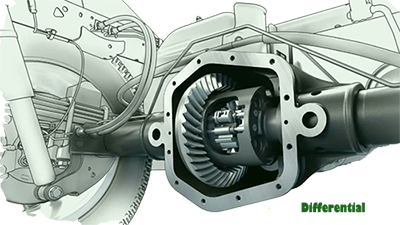 The role of the differential is to enable a vehicle's drive wheels that deliver power from the engine to rotate at deviating speeds, for example, when turning a corner.
The role of the differential is to enable a vehicle's drive wheels that deliver power from the engine to rotate at deviating speeds, for example, when turning a corner. Designed for a system of gears that sit on the same axle, the differential is the component that allows the rotating driveshaft to change the vehicle's direction.
In a rear-wheel-drive car, the driveshaft runs the vehicle's length. The differential's role is to transfer the power generated to the axle that drives the vehicle's left and right front wheels—a formula known as an open differential.
If the car being restored is a sports car, then the chances are that it will be fitted with a limited-slip differential.
Limited-slip differential was developed way back in the Thirties by Ferdinand Porsche in his pre- Volkswagen days, where his interest lay more in developing Grand Prix cars.
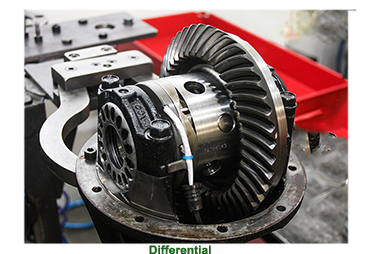 Porsche envisioned that fitting slip differential would allow a vehicle to redistribute torque to each wheel, increasing the vehicle's power and road-holding considerably.
Porsche envisioned that fitting slip differential would allow a vehicle to redistribute torque to each wheel, increasing the vehicle's power and road-holding considerably.
When appraising a car before purchase, when it comes to the differential, there is really not a lot to see as it is a compact unit, packed away out of sight in a sealed unit.
The only signs of a failing differential on a test drive will be excess vibration, the brakes binding during turns, and a range of sounds coming from the vehicle's rear, including clunking and howling.
Once the restoration car makes it to the workshop, there will be sufficient opportunities to examine the differential's interior. The first problem that will come to light is wear on shafts or bushes.
Worn bushes should be replaced immediately, as the costs involved make them not worth repairing, with new parts are inexpensive and easy to replace.
![]()
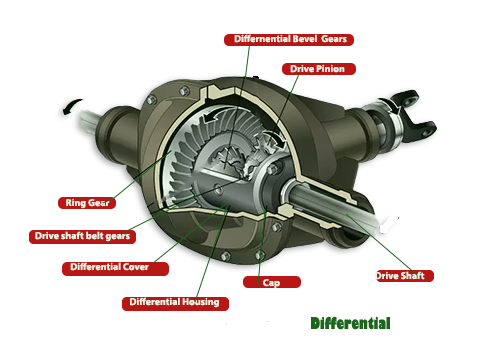 If the gears are beginning to wear, that is an entirely different proposition. The only means of checking wear in the gears is to fix the outer case of the differential and one of the axle shafts in place while at the same time checking for any signs of free movement on the second shaft.
If the gears are beginning to wear, that is an entirely different proposition. The only means of checking wear in the gears is to fix the outer case of the differential and one of the axle shafts in place while at the same time checking for any signs of free movement on the second shaft.
If the gears are in a healthy state, movement should be practically nonexistent. Any other situation will mean excessive play on the driveshaft, evidenced by loud noises coming from the transmission.
If the differential had been adequately maintained during its active years, there is no reason that it should not be in working condition. During its life, the vehicle's internal gears and bearings should have been lubricated to prevent overheating
If not, the oil begins to break down, causing the metal gears and bearings to crystalise over the years. The metal that chips off remains in the broken-down oil, exacerbating the damage.
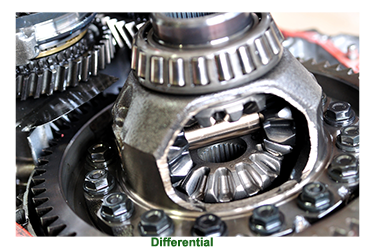 Differential oil that has not been changed regularly, can cause permanent damage not only to the differential but also spread to the transmission.
Differential oil that has not been changed regularly, can cause permanent damage not only to the differential but also spread to the transmission.
Signs of a faulty rear differential are as follows:
- When the vehicle decelerates, a loud whirring noise is clearly audible.
- When the vehicle accelerates, a whining noise can be heard.
- When the vehicle begins to move, a loud clunking noise can be heard from the vehicle's underside.
- When the vehicle starts to pick up speed, the steering will begin to vibrate.
- When the vehicle is parked, oil is liable to leak from the differential onto the road.
Repairing a differential is always a complicated affair and best left to the specialists. Each fault found in a differential requires a different type of repair- due to the intricate components that make up a differential.
These are typical repairs that will need to be carried out on a differential in the event of partial or complete failure.
![]()
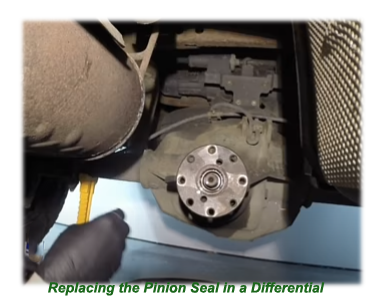 Replacing the bearings: The side bearings and pinion bearing are liable to deteriorate over time. Replacing these parts is a long and intricate procedure with the intensity of skilled labour required making it an expensive job.
Replacing the bearings: The side bearings and pinion bearing are liable to deteriorate over time. Replacing these parts is a long and intricate procedure with the intensity of skilled labour required making it an expensive job.
Replacing the Gears: If the gears have become chipped and worn down, they will need to be replaced as they play an integral part in the operation of the differential.
 Repairing these damaged parks will bes very labour intensive, making it an expensive job but much less costly than a complete gear replacement that includes the bearings, gears, housings, fluids and the necessary seals.
Repairing these damaged parks will bes very labour intensive, making it an expensive job but much less costly than a complete gear replacement that includes the bearings, gears, housings, fluids and the necessary seals.
If the vehicle shows signs of a leaking differential, two possible repairs will need to be carried out.
The first is the simplest and least expensive- replacing the gasket.
Fifties and Sixties cars were usually fitted with rubber seals that sat inside the cover; Gasket seals are liable to deteriorate over time, causing oil leaks.
Replacing a differential gasket is very straightforward and can be carried out in-house.
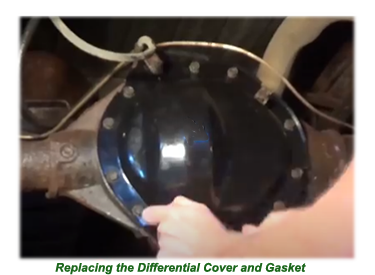 Replacing the Pinion Seal: This is a more demanding procedure requiring the yoke in front of the driveshaft to be removed. The pinion seal attached to the collar is liable to wear every two years or so. Great care must be taken when the replacement seal is inserted into the yoke.
Replacing the Pinion Seal: This is a more demanding procedure requiring the yoke in front of the driveshaft to be removed. The pinion seal attached to the collar is liable to wear every two years or so. Great care must be taken when the replacement seal is inserted into the yoke.
 Replacing the side seals: Side seals, two in number, are strategically placed to prevent the oil in the differential from leaking on to the breaks. Replacing them is a very labour intensive procedure as the entire axle assembly has to be removed entirely so that the worn-out seals can be replaced.
Replacing the side seals: Side seals, two in number, are strategically placed to prevent the oil in the differential from leaking on to the breaks. Replacing them is a very labour intensive procedure as the entire axle assembly has to be removed entirely so that the worn-out seals can be replaced.
Repairing a differential is not an expensive procedure in relation to some of the other semi-major faults discovered when restoring a classic car. Only if the damage done to a differential is totally devastating should the restorer even consider that the part be changed.
Take me back to the home page.
ub5


